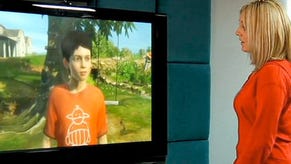E3: Post-Natal Discussion
Microsoft's Alex Kipman explains the technology.
The highlight of Microsoft's E3 press conference - apart from Gepetto Molyneux and his talking boy - was undoubtedly Project Natal. As you'll know if you've read our hands-on preview, it allows you to play games using your whole body and invisible controllers, via a camera that sits under your TV.
So far, so EyeToy - but there's more to Project Natal than that. So the project director, Alex Kipman, told us while demoing how his shiny new technology can be used to play good old Burnout Paradise. Read on to find out more about how it all works and what the future holds.
I've been working at Microsoft for about eight years, so I've been there for some time. I took on the job of creating an incubation team to think about what's next for Xbox. Don [Mattrick] challenged us to think ahead - to think beyond, to be innovative.
We thought about a wide range of things and made a team effort within Xbox to figure out where we want interactive entertainment to go. After quite a collaborative effort we landed on this, and a lot of research and a lot of sweat blended into something I think we're all very proud of.

Essentially we do a 3D body scan of you. We graph 48 joints in your body and then those 48 joints are tracked in real-time, at 30 frames per second. So several for your head, shoulders, elbows, hands, feet...
Say I'm tracking a wrist, which is what I do for Burnout. I can look at that on a single frame and I can see what direction, acceleration and confidence I have for that joint. Why is that interesting? Because it allows me to not only know where you are, but to know where you're going to be. This is how we do the directing and the predictive behaviour.
If you think about swinging a baseball bat, by the time you're halfway done with the swing, I know not only where you're going to end but when you're going to end. There are very precise and predictable ways so you can have that immediate payoff of my baseball bat hitting the baseball.

Absolutely. We see there being three types of game. We love the [existing] controller, it's not going anywhere and there will continue to be games that are specifically made to only work with a controller. We'll have games that are specifically designed to work only with Natal - not just arcadey games, but real, hardcore, triple-A titles.
Then you'll have some games that are essentially a hybrid - games that work both with the controller and with Natal. Why is that interesting? Think about a first-person shooter where I'm using the controller but I'm doing facial tracking by just moving around and looking round corners.
Or you could have a hardcore gamer like me playing a game with a controller, while a non-hardcore person sitting next to me enjoys the experience by playing with Natal. I could be having my Halo experience with the controller and the friend next to me, who's not a hardcore gamer, could be throwing grenades or driving the Warthog or doing any number of things with Natal.
We can track up to four players in the same way we track controllers. Each individual player will be able to choose - do I want to bind with a controller, or do I want to bind with my body, or do I want to bind with both?





